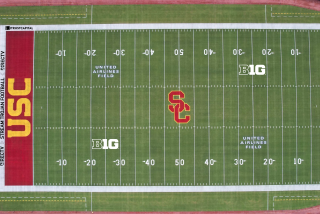Summer of Change Not Over
- Share via
The battle for independents has been waged all summer, in airport hotels and athletic department offices. From Syracuse to Miami of Florida, with a pivotal pit stop at Florida State, it has begun to change the face of college football.
There are many questions looming as the 1990 season begins, and hardly any of them have to do with what is going to take place between the goal posts. “Who’s No. 1?” has been replaced by “Who’s going where?” For now, the Heisman Trophy race is merely an afterthought.
“There’s a new rumor every day,” says Penn State athletic director Jim Tarman.
The hottest rumors involve the independents, those schools without conference affiliations (at least for football), some of whom have been as hotly pursued in the past few months as a blue-chip tailback with blazing speed.
And of the independents, none have been courted more than Miami, Florida State and Syracuse.
The most serious talk right now concerns the Seminoles, who have held preliminary discussions with both the Southeastern Conference and the Atlantic Coast Conference. The SEC is also reportedly interested in the Hurricanes, while the ACC has toyed with the idea of bringing in several teams, strictly for football, and setting up divisional play with the purpose of improving its lackluster image.
Of course, it was two notable football independents that set this commotion in motion earlier this year. Notre Dame’s decision to sign its own separate television package with NBC, a five-year package worth an estimated $35 million, and Penn State’s announced intentions to join the Big 10, put the handwriting on the wall in rather large dollar signs.
“We all might have our own school colors on Saturdays, but we have the same color the rest of the week -- green,” said the athletic director at one ACC school.
Realignment in college football these days has nothing to do with going back to the winged-T. It has to do with Arkansas leaving its 76-year association with the Southwest Conference in the dust for the greener pastures of the SEC. It has to do the possible merger between leagues to form what will come to be known as superconferences.
(Question: if the Big Sky merges with the Mid-American Conference, otherwise known as the MAC, will all pre-game meals be served with pickles and onion on a sesame seed bun?)
“The independents are going through tough times,” says Florida State athletic director Bob Goin, whose school, for the time being, is still a member of the Metro Conference in all sports but football. “Everything is pointing to being in a conference.”
Which conference to join is perhaps the biggest dilemma for some of the highly sought-after independents to figure. Would Florida State benefit more from aligning with a league strong in both football and basketball, such as the SEC, than going to the ACC, which is anxious to balance the interest between the two sports, not to mention its books?
It is certainly an enviable position for the Seminoles to be in. Florida State president Bernard Sliger has said that the school could make a decision sometime in the next two months, and until that happens, will enjoy its driver’s seat vantage point.
“From talking with everyone, I have gotten the impression that we are a key player (in expansion),” Sliger said after a meeting with ACC officials earlier this month in Orlando, Fla.
The flip side of the equation is how much expansion would help the respective leagues involved. Would a league such as the ACC, which hasn’t done poorly paying its bills in the past with only eight schools, help itself more by opening its doors to a Florida State, a Miami, a Syracuse or even a Pitt? ACC officials have maintained a veil of silence on the league’s position, but the whispers along Tobacco Road strongly suggest that the league is resisting any kind of expansion at all.
“We feel that we can contribute to the ACC in football, while the ACC would contribute to Florida State in basketball,” said Goin. “It would be positive for both sides in all sports.”
Asked about the possibility of the Seminoles joining the ACC, Virginia football coach George Welsh said, “I think it would be good. But I think that the schools in our league would have to raise their programs to Florida State’s level.”
Despite all the obvious attractions, there are some drawbacks for the independents interested in becoming part of a league, as there is for Notre Dame remaining by itself, which also seems likely. For the Fighting Irish, it might make it more difficult to play the kind of competitive schedule it seeks. For the others, there would be more obstacles inside a league than outside.
Take Penn State, for instance. The Nittany Lions won two national championships during the 1980s. Conversely, the Big Ten has not finished a season with a consensus No. 1 since Ohio State in 1968. “Winning the national championship as part of the Big Ten will be more difficult,” says Tarman, “but it won’t be out of the realm of possibility.”
More to Read
Go beyond the scoreboard
Get the latest on L.A.'s teams in the daily Sports Report newsletter.
You may occasionally receive promotional content from the Los Angeles Times.









